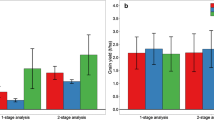Abstract
Saharan maize had been adapted to extreme conditions and could have developed resistance to different stresses. However, genebanks and breeding collections have poor representation from Saharan germplasm and, particularly, from Algeria. This is a preliminary approach to investigate the adaptation and agronomic performance of a representative sample of Saharan maize. We evaluated open-pollinated Saharan populations along with European and American cultivars during 2 years in humid and dry Spanish locations and in Algiers (Algeria). Saharan populations were able to grow in temperate environments, although results were not consistent over years and the genotype-by- environment interactions were very important. Some of the Algerian populations evaluated in 2010 showed promising yield and anthesis silking interval over environments, but none of the Algerian populations evaluated in 2009 were adequately adapted to Spanish conditions. These results suggest that there are wide ranges of variability within Saharan maize for adaptation to temperate conditions, and further evaluations of Saharan maize should identify potential base populations for breeding maize in either side of the Mediterranean Sea. However, this germplasm requires prebreeding for adaptation to temperate conditions in order to be adequate for breeding programs in temperate areas.
Similar content being viewed by others
References
Abera W, Van Rensburg JBJ, Labuschagne MT, Maartens H (2004) Genotype-environment interactions and yield stability analyses of maize in Ethiopia. S Afr J Plant Soil 21:251–254
Badu-Apraku B, Fakorede MAB, Lum AF, Menkir A, Ouedraogo M (2007) Demand-driven technologies for sustainable maize production in West and Central Africa. In: Proceedings of the fifth biennial regional maize workshop, IITA-Cotonou, Bénin, 3–6 May, 2005. WECAMAN/IITA, Ibadan
Beyene Y, Botha AM, Myburg AA (2006) Genetic diversity among traditional Ethiopian highland maize accessions assessed by simple sequence repeat (SSR) markers. Genet Resour Crop Evol 53:1579–1588
Gomes E, Gama EE, Parentoni SN, Patto Pacheco CA, De Oliveira AC, De Oliveira Guimarães PE, Dos Santos MX (2000) Yield stability of maize germplasm evaluated in several regions of Brazil. Pesq Agripec Bras 35:1143–1149
Grigg DB (1974) The agricultural systems of the world: an evolutionary approach. Cambridge University Press, UK
Hafnagel HP (1961) Agriculture in Ethiopia. FAO, Rome
Hawtin G, Iwanaga M, Hodgkin T (1996) Genetic resources in breeding for adaptation. Euphytica 92:255–266
Revilla P, Soengas P, Malvar RA, Cartea ME, Ordás A (1998) Isozyme variation and historical relationships among the maize races of Spain. Maydica 43:175–182
Revilla P, Boyat A, Álvarez A, Gouesnard B, Ordás B, Rodríguez VM, Ordás A, Malvar RA (2006) Contribution of autochthonous maize populations for adaptation to European conditions. Euphytica 152:275–282
Romay MC, Malvar RA, Campo L, Álvarez A, Moreno-González J, Ordás A, Revilla P (2010) Climatic and genotypic effects for grain yield in maize under stress conditions. Crop Sci 50:51–58
Ruiz Corral JA, Durán Puga N, Sánchez González JJ, Ron Parra J, González Eguiarte DR, Holland JB, Medina García G (2008) Climatic adaptation and ecological descriptors of 42 Mexican maize races. Crop Sci 48:1502–1512
Sanou J, Gouesnard B, Charrier A (1997) Isozyme variability in West African maize cultivars (Zea mays L.). Maydica 42:1–11
SAS Institute (2005) The SAS system, SAS Online Doc HTML format version 9. SAS Inst., Cary
Setimela PS, Vivek B, Bänziger M, Crossa J, Maideni F (2007) Evaluation of early to medium maturing open pollinated maize cultivars in SADC region using GGE biplot based on the SREG model. Field Crops Res 103:161–169
Soldati A, Stehli A, Stamp P (1999) Temperature adaptation of tropical highland maize (Zea mays L.) during early growth and in controlled conditions. Eur J Agron 10:111–117
Steel RDG, Torrie JH, Dickey DA (1997) Principles and procedures in statistics: a biometrical approach, 3rd edn. Mc Graw Hill, New York
Weatherwax P, Randolph LF (1955) History and origin of maize. In: Sprague GF (ed) Corn and corn improvement. Academic Press Inc., New York, pp 1–61
Acknowledgments
This research was supported by the Agencia Española de Cooperación y Desarrollo (AECID), the Spanish Council for Scientific Research (CSIC), and the École Nationale Supérieure Agronomique, El Harrach-Algiers. A. Djemel has a JAE Pre contract from CSIC.
Author information
Authors and Affiliations
Corresponding author
Rights and permissions
About this article
Cite this article
Djemel, A., Revilla, P., Hanifi-Mekliche, L. et al. Maize (Zea mays L.) from the Saharan oasis: adaptation to temperate areas and agronomic performance. Genet Resour Crop Evol 59, 1493–1504 (2012). https://doi.org/10.1007/s10722-011-9778-2
Received:
Accepted:
Published:
Issue Date:
DOI: https://doi.org/10.1007/s10722-011-9778-2




